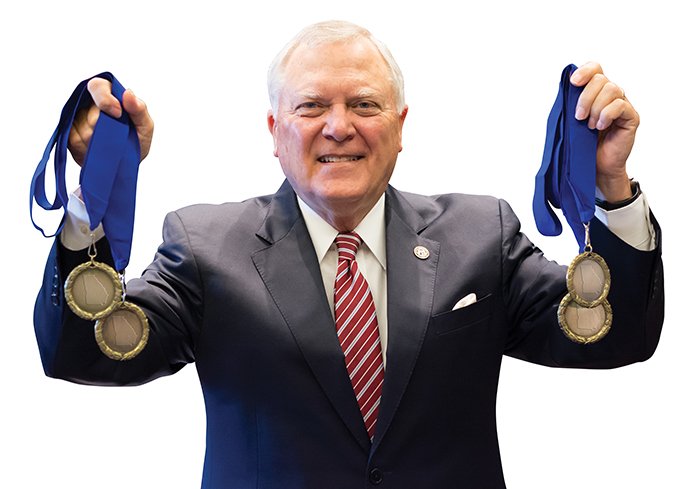It’s hard enough to maintain a first-place finish in Site Selection’s annual ranking of state business climates three years in a row. Georgia did that last year. This year, it extends that winning streak with a fourth consecutive top billing. This ranking combines an equal share of subjective and objective criteria.
Fifty percent of the ranking is based on a survey of site selectors – corporate facility investors and site consultants — who indicate simply which states they deem to be the most business friendly. Texas and South Carolina were first and second by that measure, followed by Georgia. At 50 percent of the total, a third-place finish earned Georgia significant points. That’s the subjective part. The other 50 percent — the objective side — is a combination of factors primarily based on announced project data resident in the Conway Projects Database (see the methodology below), which credits areas with corporate facility projects of at least $1 million in capital investment, 20 or more new jobs or new construction of at least 20,000 sq. ft.
Site Selection’s 2016 Top State Business Climate Rankings
| Overall Rank | State | Survey Rank | Comp. Rank | 2015 NP Rank | 2015 NP Rank PC | 2016 NP Rank | 2016 NP Rank PC | Mature Firm TI Rank | New Firm TI Rank | Final Total Points |
|---|---|---|---|---|---|---|---|---|---|---|
| 1 | Georgia | 3 | 7 | 7 | 16 | 1 | 4 | 3 | 6 | 97 |
| 2 | North Carolina | 5 | 2 | 4 | 7 | 4 | 10 | 7 | 13 | 94 |
| 3 | Ohio | 11 | 8 | 2 | 3 | 8 | 13 | 5 | 3 | 90 |
| T4 | Tennessee | 4 | 3 | 11 | 13 | 6 | 8 | 29 | 29 | 89 |
| T4 | Texas | 1 | 1 | 1 | 11 | 15 | 34 | 12 | 42 | 89 |
| 6 | Virginia | 6 | 13 | 9 | 18 | 2 | 3 | 11 | 39 | 87 |
| T7 | Louisiana | 13 | 11 | 13 | 6 | 5 | 2 | 10 | 2 | 84 |
| T7 | South Carolina | 2 | 18 | 19 | 19 | 11 | 9 | 32 | 34 | 84 |
| 9 | Alabama | 8 | 16 | 15 | 10 | 19 | 20 | 13 | 19 | 83 |
| 10 | Indiana | 6 | 6 | 10 | 12 | 17 | 21 | 43 | 15 | 82 |
| 11 | Florida | 9 | 9 | 14 | 41 | 10 | 23 | 19 | 36 | 75 |
| 12 | Oklahoma | 14 | 28 | 23 | 15 | 20 | 18 | 16 | 5 | 74 |
| 13 | Utah | 10 | 24 | 32 | 30 | 29 | 22 | 6 | 10 | 73 |
| 14 | Kentucky | 28 | 5 | 5 | 1 | 7 | 6 | 18 | 7 | 69 |
| T15 | Illinois | 24 | 14 | 3 | 4 | 3 | 11 | 45 | 24 | 68 |
| T15 | Iowa | 19 | 10 | 21 | 8 | 12 | 7 | 40 | 41 | 68 |
| T15 | Michigan | 27 | 4 | 6 | 14 | 8 | 12 | 25 | 25 | 68 |
| T18 | Arizona | 15 | 22 | 25 | 33 | 14 | 19 | 14 | 31 | 67 |
| T18 | Mississippi | 12 | 25 | 30 | 25 | 20 | 14 | 37 | 21 | 67 |
| 20 | Nebraska | 36 | 12 | 16 | 2 | 13 | 1 | 9 | 1 | 60 |
| 21 | Nevada | 18 | 15 | 28 | 21 | 38 | 36 | 4 | 38 | 59 |
| 22 | South Dakota | 26 | 21 | 36 | 9 | 46 | 46 | 2 | 11 | 54 |
| 23 | Kansas | 20 | 17 | 20 | 5 | 38 | 37 | 47 | 48 | 52 |
| 24 | New York | 17 | 29 | 18 | 43 | 24 | 41 | 42 | 37 | 49 |
| 25 | Wisconsin | 34 | 26 | 17 | 20 | 31 | 33 | 35 | 4 | 47 |
This year’s ranking, like those of previous years, illustrates the enduring strength of the US South as a destination for corporate expansion. Ohio (third) and Indiana (10th) made the top 10, but all others in that group can be found south of the Mason-Dixon Line.
North Carolina finishes in second place overall, as it did last year, despite calls to avoid investing there due to a bathroom-access law that passed earlier in 2016. It also ranks in the top tier in the competitiveness component of the business climate ranking, meaning plenty of companies still want a Tar Heel business facility in their portfolio, whether or not some sporting events move their contests elsewhere or a handful of companies cancel their North Carolina expansions. It still has the workforce, climate and infrastructure (transportation, regulatory and otherwise) deemed necessary by capital investors.
Progress Report
Georgia Governor Nathan Deal met with me in October to discuss the business climate achievements that are resonating with investors in 2016 and to explain his agenda for maintaining his state’s momentum going forward.
“By our calculations, we are right at 540,500 new private-sector jobs since I took office in January 2011,” the governor points out. “A lot of that is coming from our Department of Economic Development’s Global Commerce initiative,” he adds, using the pre-2016 Mercedes-Benz and Porsche North America headquarters announcements as examples. The governor credits the department with assisting in creating more than 25,300 new jobs and $4.4 billion in capital investment in FY16 alone.
Georgia’s Rainy Day Fund, which was virtually depleted in 2011, is now in excess of $2 billion, notes the governor, a target he had set for when he leaves office in early 2019. “We will continue to add to that, and that is done through conservative budgeting,” says the governor. “We budget every year on anticipated revenue growth, and this year, as in past years, we have exceeded it considerably.” Fiscal soundness, which the governor knows is of great importance to investing corporations, has helped the Peach State maintain its AAA bond ratings. By one measure — Ranking the States by Fiscal Condition 2016 Edition, from the Mercatus Center at George Mason University — Georgia’s fiscal soundness is average, ranking 23rd of the 50 states and Puerto Rico. The study ranks states on five measures of financial solvency.

Another measure, the Tax Foundation’s 13th annual State Tax Business Climate Index, released September 28th, ranked Georgia as having the 36th most competitive tax code in the US. The Index incorporates six taxes: overall tax climate, corporate, individual income, sales, property and unemployment insurance. Georgia’s highest ranking of these is 10th nationally in corporate tax structure.
“That’s something we hope to do something about,” says the governor. “Those are difficult for anyone to rank. If you look on the surface, states that don’t have an income tax would rank very high. But the reality is they make up for it with a lot of other types. Our 6 percent personal income tax rate roughly creates 50 percent of the revenue of the State of Georgia. Even though I am a Fair Tax proponent, when you are confronted with that reality, saying you will shift to a consumption-based sales tax approach, there are several things to consider. One is sales tax is not as reliable on a sustained basis as income tax is.
“But if you look at it overall,” he adds, “we’ve balanced things very well. I don’t hear people thinking of moving their businesses here complaining about that. We’ve made other adjustments in terms of regulatory reforms, making it easier for them to get operational, and we have a lot of credits available for job creation and other purposes that really reduce the effective tax rate in the business category.”
Getting Infrastructure Right
Infrastructure and transportation is a signature issue of Gov. Deal’s in 2016, as is the Opportunity School District initiative to rescue failing Georgia schools. Voters were weighing in on Amendment 1 pursuant to the latter as this issue went to press.
House Bill 170, passed two legislative sessions ago, appropriated about $1 billion in additional revenue for transportation and infrastructure improvements. “We have recently released a 10-year [$10-billion] plan with 11 major projects, and an 18-month plan that will conclude next summer that includes about 2,500 miles of resurfaced roads, about 300 bridges that have been repaired and improved and about 100 bridges replaced in that timeframe,” Gov. Deal relates. “Those improvements would not have been possible without the General Assembly stepping up and changing the method of financing our infrastructure improvements.”

Additional funds are allocated to Georgia’s ports, including to the Savannah Harbor Expansion Project and a new, intermodal inland Appalachian Regional Port scheduled to open in 2018 in northwest Georgia. It’s forecast to handle 50,000 containers in its first year, a figure that will double within 10 years, significantly reducing Interstate traffic congestion.
“This port will give access to companies in about four states, to put their cargo on rail and transport it directly to the Port of Savannah,” the governor elaborates. An existing inland port in Cordele is ramping up to handle logistics for the Kia manufacturing plant in West Point, Georgia. “The Georgia Ports Authority has big plans for joining the two major railroads that both have major terminals inside the Savannah port into a mega terminal that will expand their capacity and allow them to load larger trains in terms of cars before they ever leave the port property,” he adds.
Film Industry, Workforce Initiatives Post Gains
Georgia’s film and television industry surpassed $7 billion in economic impact in 2016 — a $1-billion increase over the previous fiscal year.
“It is continuing to have the permanency we want,” says the governor. “We’re continuing to see the soundstages built and the infrastructure development that was not present initially. I just met with the head of Pinewood Studios, and they are completing their third phase at Pinewood, which will mean 18 more sound stages — they have plans to continue that and to diversify what they are doing.” More than 100 companies that cater to this industry have opened recently, adding to the state’s organic growth of the sector as fewer such workers are coming from out of state. More than 130 students are enrolled in the state’s Georgia Film Academy this fall at four state technical colleges.
The governor is happy to report significant progress in other education-based workforce development initiatives, such as Move on When Ready, where high school students dual enroll in college credit programs.
2016 Executive Survey Business Climate Rankings
| 1 | Texas |
| 2 | South Carolina |
| 3 | Georgia |
| 4 | Tennessee |
| 5 | North Carolina |
| T6 | Indiana |
| T6 | Virginia |
| 8 | Alabama |
| 9 | Florida |
| 10 | Utah |
“In this current school year, we have about 17,000 high school students taking 167,000 credit hours while still in high school in our technical colleges and in our colleges and universities,” he reports. “This is all being paid for by the State of Georgia. It cuts down on student debt and accelerates completion of their education requirements. That will prove to be one of the most successful things we’ve done in terms of education reform.”
A Strategic Industries Workforce Development Grant seeks to fill jobs going unfilled in Georgia by funding tuition at technical colleges in 12 disciplines, including film — 205 majors are included in that program. Enrollment in these programs tops 22,200, up 11 percent from 19,745 last year.
Improving the high school graduation rate is among the governor’s legislative priorities in the next session. The rate has risen 11 points over the past five years, “but we still have a way to go,” he relates. More immediate is the governor’s plan to address chronically failing schools, which he believes will improve the graduation rate. This is the Opportunity School District (OSD) amendment on the November ballot that if passed would turn over to state control up to 20 failing schools per year in order to improve their outcomes. Such schools — 127 of them — for three or more years have never scored above an F; about 68,000 students are enrolled in such schools.
“We’re hoping schools will come in, be rehabilitated and then rotate back out,” says Gov. Deal.
Do businesses take notice of local school success rates, or is that off their location assessment radar? They notice, says the governor.
“One example is from the standpoint of what the workforce will look like,” he explains. “We’ve now created in excess of 540,000 jobs in not quite six years. In that same timeframe, we’ve had more than 100,000 students drop out of school. And not a single one of those 540,000 jobs are available to the high school dropouts. The criteria for those jobs is far beyond that. This OSD proposition is a first big step in doing something about it. Chronically failing schools have a graduation rate of only 55.7 percent. That’s 23 percentage points below our average graduation rate.”
What’s Next?
What Matters Most:
Site Selectors’ Most Important Location Criteria
| 1 | Workforce skills |
| 2 | Incentives |
| 3 | State and local tax scheme |
| 4 | Transportation infrastructure |
| 5 | Land/building prices and supply |
| 6 | Workforce development |
| T7 | Utilities (cost, reliability) |
| T7 | Higher education resources |
| 9 | Ease of permitting and regulatory procedures |
| 10 | Quality of life |
Now home to major operations of, among others, Kia, Porsche North America and Mercedes-Benz (when its new North American headquarters in Sandy Springs is complete), Georgia claims some significant foreign direct investment wins from Europe and Asia. Governor Deal also sees potential investment from Latin America.
“I still think we have not maxed out on the growth of industry and businesses coming from Europe, Japan and our other traditional, high-level trading partners,” he notes. “The primary factor driving that is energy. When you look at the announced intention of the German government to phase out all of their nuclear generating facilities, [I was told] businesses there will have to buy more energy from France, or oil and gas from Russia. I thought to myself, no wonder we’re seeing so many of your companies interested in coming our way, the most recent being Adidas, which is coming to Cherokee County with their first US plant, right here in Georgia. We still have great opportunities in our traditional trading partners.”
The interview with the governor concluded with this question: Which Georgia business climate attribute is most overlooked? What’s the story that doesn’t get told?
“It’s the fact that finally local communities that have wanted to have more job opportunities have recognized that they have to re-examine reasons why companies may not come to that community,” he responded. “Such as, how difficult is it to get permits to create a new plant? If you’re creating impediments, they may go somewhere else. That message has gotten out in Georgia. So instead of a company only talking to our state economic development department, more and more local economic developers are very active on their own and in conjunction with the state. That is a change that has happened in the last 10 years, and it’s a good thing. Companies that come here aren’t just going to the proverbial place to be. The place to be now is almost anywhere in Georgia.”


